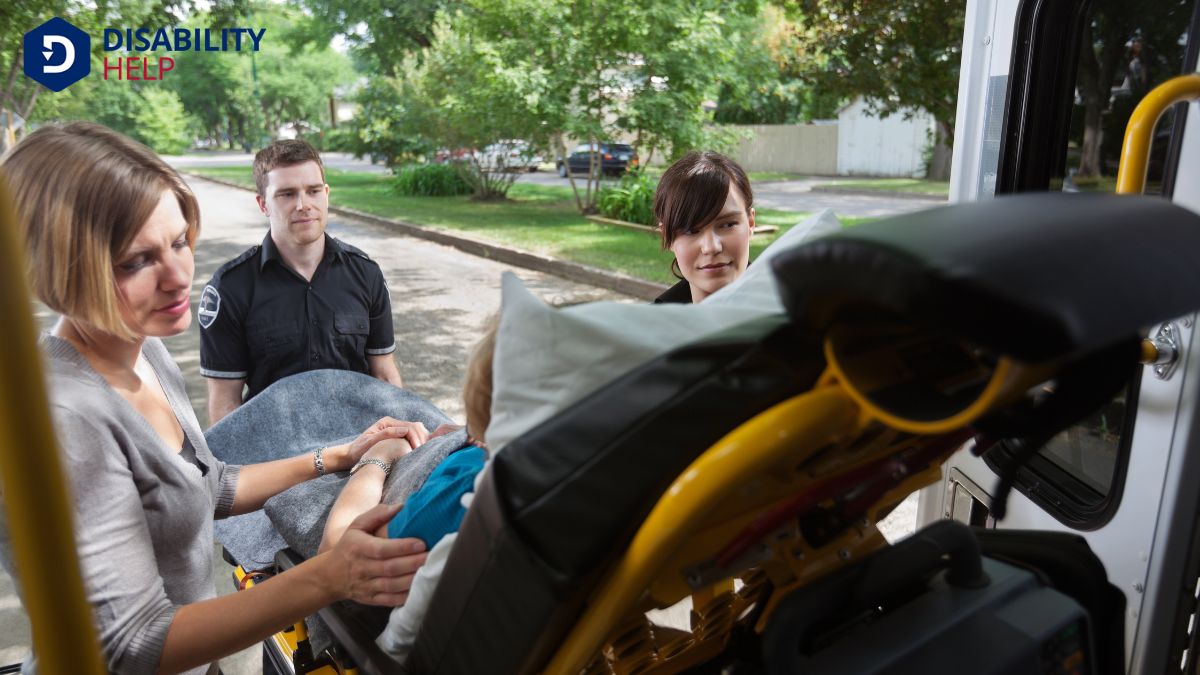Let's explore the Americans With Disabilities Act (ADA)A U.S. law that prohibits discrimination against individuals with disabilities in all areas of publi... Transportation Policy together. As a key part of the ADA, this policy guarantees accessible transportation for individuals with disabilities, promoting independence through features like ramps and priority seating. It also mandates wheelchair accessibilityThe design of products, devices, services, or environments to be usable by people with disabilities.... and complementary paratransit servicesTransportation services designed to accommodate individuals with disabilities who cannot use regular.... But how do public transit agencies manage these requirements, and what challenges do they face in implementation? There's a lot more to uncover in this critical area.
Key Takeaways
- The ADA transportation policy ensures equal accessThe principle that all individuals, including those with disabilities, should have equal opportunity... to transportation services for individuals with disabilities.
- It mandates wheelchair accessibility for buses and trains, including safe boarding and exiting.
- Transit agencies must provide complementary paratransit services for those unable to use standard transit.
- Ongoing staff training and maintenance of accessible features are required for compliance.
- The policy promotes inclusivity and independence through accessible public transit options.
Overview of the Americans With Disabilities Act

The Americans With Disabilities Act (ADA) stands as a landmark piece of legislation that transformed the landscape of civil rightsThe rights of individuals to receive equal treatment under the law, including protection against dis... for individuals with disabilities. Enacted in 1990, the ADA aims to eliminate discrimination and guarantee equal opportunities for everyone with disabilities.
By establishing extensive protections, it covers employment, public services, public accommodationsModifications or adjustments in healthcare settings to support patients with disabilities., and telecommunications. It's clear that the ADA is significant because it acknowledges the rights of millions who face barriers in everyday life.
It creates a legal framework that mandates reasonable accommodations and prohibits discriminatory practices. As we navigate through its provisions, we appreciate how the ADA has paved the way for more inclusive and accessible environments.
Together, we can continue to champion these rights and promote understanding and equityFairness and justice in the way people are treated, especially in the allocation of resources and op....
Transportation Accessibility Requirements Under the ADA
While the ADA encompasses various aspects of life, transportation accessibility remains a significant focus. We all understand how important it is for individuals with disabilities to have equal access to transportation options.
Under the ADA, transportation services must be accessible to everyone, guaranteeing that no one is left out. This includes making buses and trains wheelchair accessible, providing adequate space and equipment, and guaranteeing safe boarding and exiting.
It's essential that we work together to achieve compliance with these requirements to promote inclusivity. Additionally, the ADA mandates that transportation providers offer complementary paratransit services to individuals unable to use regular transit systems.
Role of Public Transit Agencies in ADA Compliance
As we turn our focus to the role of public transit agencies in ADA compliance, it's essential that we guarantee our transit services are accessible to everyone.
We must prioritize training for inclusive practices so that all staff understand and support the needs of individuals with disabilities.
Together, we can create a transit system that truly serves all members of our community.
Ensuring Accessible Transit Services
Maneuvering public transportation should be a straightforward experience for everyone, yet for individuals with disabilities, it often presents unique challenges.
As public transit agencies, we play a critical role in ensuring accessible transit services for all. We must adhere to ADA guidelines by providing features like wheelchair-accessible buses and elevators at stations. Our commitment includes maintaining these features in working order and promptly addressing any issues.
It's not just about compliance; it's about fostering independence and dignity. By offering clear signage, audible announcements, and priority seating, we can make travel easier for passengers with disabilities.
We also need to engage with our community, gathering feedback to improve services. Together, let's create a transit system that truly serves everyone.
Training for Inclusive Practices
Our commitment to accessible transit services extends beyond physical infrastructure to encompass how we operate daily.
We recognize that to truly serve all passengers; we must equip our staff with the skills and awareness necessary to meet diverse needs.
Inclusive practices in public transit are essential, and training plays a significant role in ensuring ADA compliance.
By focusing on education and empathyThe ability to understand and share the feelings of another, particularly important in understanding..., we can make every rider's journey smoother.
Through our training programs, we emphasize:
- Effective Communication: Teaching staff how to engage with passengers who've different abilities.
- Empathy and Awareness: Cultivating an understanding of the challenges faced by individuals with disabilities.
- Operational Protocols: Ensuring procedures are in place to assist all passengers efficiently.
- Continuous Improvement: Regularly updating training to reflect best practices and new insights.
Impact of ADA Transportation Policy on Mobility
Let's explore how the ADA transportation policy has transformed mobility for individuals with disabilities.
We've seen significant improvements in accessible public transit options and an increase in the availability of paratransit services, both essential for enhancing independence.
As transportation infrastructure continues to improve, it becomes easier for everyone to navigate their communities.
Accessible Public Transit Options
How has the Americans with Disabilities Act (ADA) transformed public transit for individuals with disabilities?
It has greatly improved accessibility, ensuring everyone can travel more independently. Public transit systems have implemented changes to accommodate diverse needs.
We've seen:
- Ramps and elevators: These are now standard in stations, aiding wheelchair users and others with mobility challenges.
- Visual and auditory aids: Clear signage and announcements assist those with visual or hearing impairments in maneuvering systems.
- Priority seating: Reserved spaces on buses and trains make it easier for those with disabilities to travel comfortably.
- Training for staff: Transit employees are trained to assist passengers with disabilities, ensuring a safer and more inclusive experience.
These enhancements reflect ADA's commitment to accessible public transport for all.
Paratransit Services Availability
While accessible public transit is vital, not all individuals with disabilities can use traditional systems. That's where paratransit services come in.
Under the ADA, these services provide an essential travel option for those unable to navigate standard transit routes due to physical or cognitive limitations.
Paratransit operates as a door-to-door or curb-to-curb service tailored to meet individual needs. This service guarantees we all have equitable access to mobility, allowing people with disabilities to participate fully in community life.
Transportation Infrastructure Improvements
The ADA transportation policy has greatly impacted mobility by driving infrastructure improvements nationwide.
As we've observed, these enhancements make travel more accessible for everyone, not just those with disabilities.
Let's explore some key areas where the ADA has influenced infrastructure:
- Accessible Public Transit: Buses and trains now feature ramps, lifts, and priority seating, making them usable for individuals with mobility challenges.
- Improved Sidewalks: Curb cutsRamps built into sidewalks or curbs to allow easier access for wheelchairs and those with mobility i... and tactile paving guarantee sidewalks are navigable for wheelchair users and those with visual impairments.
- Enhanced Signage and Communication: Clearer, more accessible information in stations and vehicles helps all riders, including those with cognitive disabilities.
- Parking Modifications: Designated accessible parking spaces in public and private lots guarantee easier access to transportation hubs.
These changes reflect our commitment to inclusivity in transportation.
Challenges Faced in Implementing ADA Transportation Standards
Despite the passage of the Americans with Disabilities Act over three decades ago, we still encounter significant challenges in implementing ADA transportation standards.
Many public transport systems, particularly older infrastructure, struggle with accessibility upgrades due to financial constraints and logistical hurdles. Retrofitting buses, trains, and stations can be costly and time-consuming, often requiring extensive modifications.
Additionally, there's a lack of uniformity across different regions, as some areas prioritize accessibility while others lag behind. This inconsistency creates confusion and limits mobility for individuals with disabilities.
Furthermore, training staff to assist passengers with disabilities properly remains an ongoing challenge. As we endeavor for inclusivity, we must address these barriers, ensuring that everyone has equal access to transportation, regardless of their abilities.
Innovations and Advancements in Accessible Transportation
As we look towards the future, exciting innovations and advancements in accessible transportation are emerging that promise to transform how people with disabilities navigate their communities.
These developments enhance mobility and provide greater independence.
Let's explore a few breakthroughs:
- Autonomous Vehicles: Self-driving cars are being designed with features to accommodate various disabilities, offering safe, reliable transport.
- Smart City Integration: Cities are adopting smart technology, like real-time data and interactive maps, to improve accessibility and efficiency in public transit systems.
- Advanced Wheelchair Lifts: New lifts are smoother and faster, making public transport more accessible and less time-consuming.
- App-Driven Services: Apps now offer tailored options for disabled riders, providing seamless, on-demand transport solutions.
These innovations are paving the way for an inclusive transportation future.
Legal and Regulatory Framework Governing ADA Transportation
When considering the legal and regulatory framework governing ADA transportation, it's essential to understand how these laws guarantee equitable access for individuals with disabilities.
The ADA mandates that public transit systems provide accommodations, guaranteeing that transportation is accessible and non-discriminatory.
We must recognize the role of Title II, which focuses on public entities, and Title III, which addresses private entities offering transportation services.
The Department of Transportation (DOT) enforces these provisions, requiring transit agencies to provide features like wheelchair lifts, priority seating, and accessible communication.
Compliance assures that individuals with disabilities can travel with independence and dignity.
We should appreciate how these legal structures work together, creating a transportation environment where everyone, regardless of ability, can participate fully in society.
Future Directions for Enhancing Transportation Access for People With Disabilities

Looking forward, it's essential we prioritize the enhancement of transportation access for people with disabilities by leveraging technological advancements and innovative practices.
We can explore a variety of approaches to improve accessibility and inclusivity.
- Smart transportation systems: Implementing technology like GPS and real-time updates can help users navigate more efficiently and independently.
- Universal designThe design of products, environments, and services to be usable by all people, to the greatest exten...: Ensuring that all transportation vehicles and infrastructure are designed to accommodate everyone, regardless of ability.
- Ride-sharing services: Encouraging the development of accessible options within popular ride-sharing platforms to expand mobility choices.
- Policy advocacyThe act of arguing in favor of, supporting, or defending the rights and interests of individuals or ...: Supporting legislation that promotes funding and research for accessible transportation solutions.
Conclusion
To summarize, we've seen how the ADA Transportation Policy greatly enhances mobility for individuals with disabilities. By mandating accessibility features like ramps, elevators, and priority seating and requiring transit agencies to provide complementary paratransit services, the policy empowers users with greater independence. Despite facing challenges in implementation, continuous innovations and advancements hold promise for the future. Let's remain committed to improving transportation access, ensuring everyone can enjoy the freedom and benefits of inclusive transit systems.






